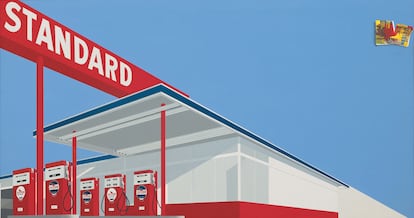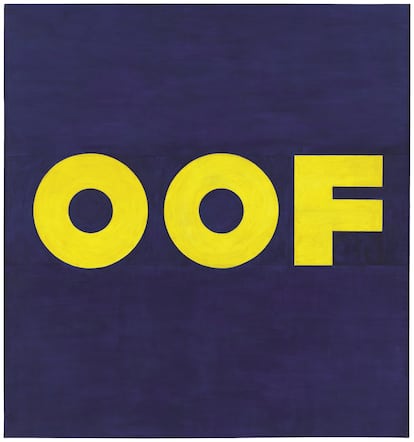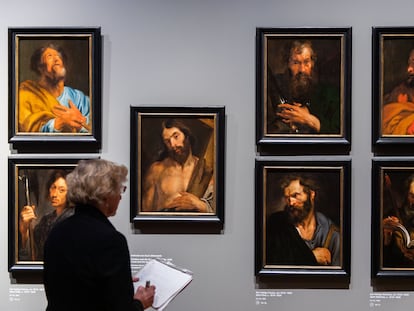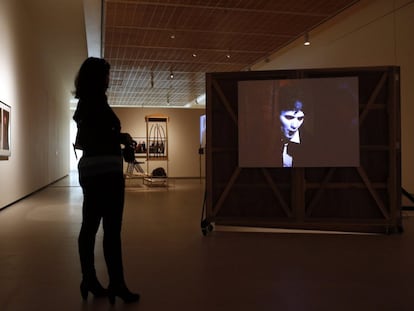On the road with Ed Ruscha, chronicler of the decline of the American empire
The retrospective that MoMA has dedicated to the pop and conceptual work of the veteran artist is a triumph and one of the cultural events of the fall in New York

There are artists of their time and artists who time ends up proving right. And then there is Ed Ruscha, both an archetype and a visionary. The exhibition that MoMA has dedicated to him — rightly one of the cultural highlights of the New York fall — presents the Ruscha who knew how to capture the United States in which he grew up, an America of billboards and gas stations, with typographic advertisements and endless streets to be best admired from the car. But he is also the guy who could open an Instagram account tomorrow and gain followers with frozen messages on a neutral background, as in the 1974 egg yolk on moiré fabric piece People Getting Ready to Do Things.
The title of the exhibition, Now Then, is therefore eloquent. Now and then, his art, fiercely local — from Oklahoma City, the city in which he grew up, to Los Angeles, the metropolis of which he became a graphic chronicler and unofficial archivist — speaks of the splendor of the empire as much as its decline, always new and yet so old. With it, MoMA bids farewell before it is too late to one of the great American creators of the second half of the 20th century, a totem between conceptual and pop art, who at the age of 85 has attended a tribute that will continue from April at the LACMA (Los Angeles County Museum of Art), an institution that he set on fire in one of his most famous works of the sixties, also included in the New York exhibition.

In one of the panels of the MoMA exhibition — with its more than 200 pieces, including paintings, drawings, photographs, videos and installations, it is his most complete to date — Ruscha apologizes for not having had a “Seine River, like Monet.” “I had, at least, Route 66 between Oklahoma and Los Angeles.” The truth is that he also had other things at his disposal: from the camera to the comic strips of orphan Annie, or the spelling of the guttural monosyllables, “OOF”, “HONK”, “SMASH” or “BOSS”, which he painted at the beginning of his career after returning from a revealing road trip through Europe.
Onomatopoeias soon took him to the iconic perspectives of gas stations in Amarillo (Texas) and to feed into the great mythology of the West with his panoramic views of the Hollywood logo while the twilight burns (another fire) or photobooks as memorable as Twentysix Gasoline Stations (1962), Some Los Angeles Apartments (1965), Every Building on the Sunset Strip (1966) or Nine Swimming Pools and a Broken Glass (1968), all of them printed without any solemnity, using cheap techniques and long runs. It is a success for Christopher Cherix, chief curator of paintings and graphic works at the museum, who has displayed them in the center of the exhibition spaces, with the same honors as the pictorial work.

From the first few rooms of the exhibition it is already clear that Ruscha’s art, a conjurer of the word as another found object, screams from the canvas. Then you learn that it also smells, and stains. That is what he aspires to, among other experiments with textures of maple syrup or gunpowder during his years of “romance with liquids,” the piece Chocolate Room, a room covered in cocoa from floor to ceiling created for the Venice Biennale of 1970 and which is now recreated in New York as an idea frozen in time. It is inevitably one of the highlights of the exhibition, but also one of the most banal works on the tour.
So much multidisciplinary dalliance links him to other “made in America” artists, like Bruce Conner, who are obsessed with popular culture. Unlike him, Ruscha seems comfortable in the short and effective message, to which he would end up returning in his work from the eighties and nineties, decades in which the color fields of the beginning of his career occasionally gave way to a gloomy black and white. With the new century, a period that was somewhat reluctantly dismissed in the exhibition, the discovery of nature seems to arrive for Ruscha, with the Californian mountains that serve as a background for the messages, as always, somewhere between dadaist and profound (”Don’t pay anything until April ”), as well as the more explicitly political and less interesting art, exemplified by the tattered American flag he painted during Donald Trump’s first year in the White House.

In another example of his fearless sense of humor, Ruscha created for the first major exhibition dedicated to his career (at the San Francisco Museum of Modern Art in 1982) a drawing with the message in white dry-wood letters “I Don’t Want No Retro Spective.” It was his way of downplaying his importance, another constant of his creative process, which, in light of the exhibition that MoMA is now dedicating to him, can only be interpreted as a definitive act of false modesty. The exhibition and its catalog refute this idea by presenting the artist beyond the clichés of the road, gas stations and the American dream, which is best understood seen as a whole, as a creator in continuous dialogue with himself, capable of being deep and entertaining at the same time. The tribute to one of his great exponents also leaves a feeling of nostalgic longing for mass culture as a lingua franca for the analysis of what happens to us. A meeting point that the cataclysm of social networks and their cacophonous cocktail of identities have wiped from the map.
‘Ed Ruscha / Now Then’, MoMA, New York. Until January 13, 2024.
Sign up for our weekly newsletter to get more English-language news coverage from EL PAÍS USA Edition
Tu suscripción se está usando en otro dispositivo
¿Quieres añadir otro usuario a tu suscripción?
Si continúas leyendo en este dispositivo, no se podrá leer en el otro.
FlechaTu suscripción se está usando en otro dispositivo y solo puedes acceder a EL PAÍS desde un dispositivo a la vez.
Si quieres compartir tu cuenta, cambia tu suscripción a la modalidad Premium, así podrás añadir otro usuario. Cada uno accederá con su propia cuenta de email, lo que os permitirá personalizar vuestra experiencia en EL PAÍS.
¿Tienes una suscripción de empresa? Accede aquí para contratar más cuentas.
En el caso de no saber quién está usando tu cuenta, te recomendamos cambiar tu contraseña aquí.
Si decides continuar compartiendo tu cuenta, este mensaje se mostrará en tu dispositivo y en el de la otra persona que está usando tu cuenta de forma indefinida, afectando a tu experiencia de lectura. Puedes consultar aquí los términos y condiciones de la suscripción digital.
More information
Archived In
Últimas noticias
Welcome to the post-religion era: The idea of Christianity as the absolute truth has become obsolete
‘I thought you would like it’: The risky sexual practice popularized by TV shows and TikTok
The digitalization of tourism: ‘They promise experiences and gave us the worst possible one’
Mexican peso defies uncertainty with forecasts of a new period of stability in 2026
Most viewed
- Sinaloa Cartel war is taking its toll on Los Chapitos
- Oona Chaplin: ‘I told James Cameron that I was living in a treehouse and starting a permaculture project with a friend’
- Reinhard Genzel, Nobel laureate in physics: ‘One-minute videos will never give you the truth’
- Why the price of coffee has skyrocketed: from Brazilian plantations to specialty coffee houses
- Silver prices are going crazy: This is what’s fueling the rally











































